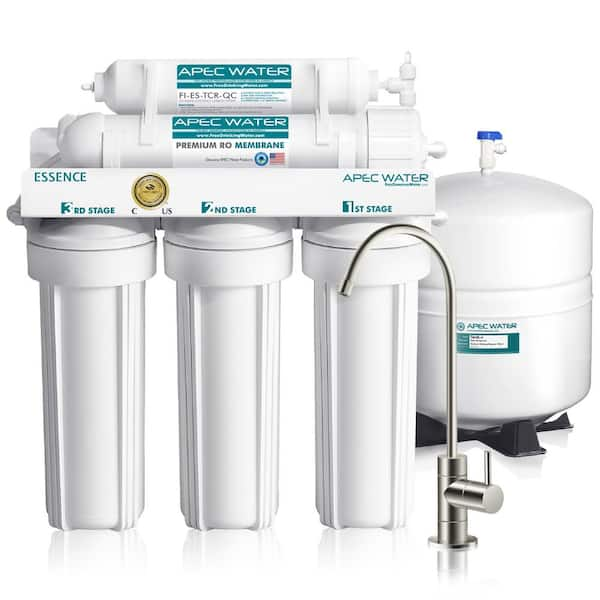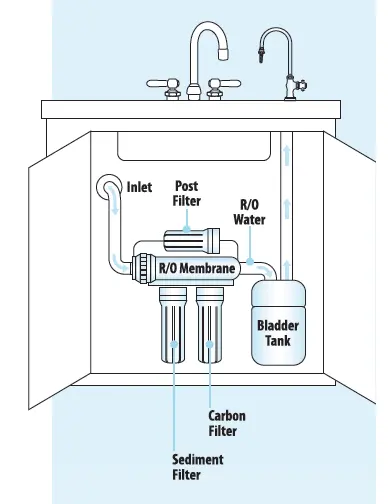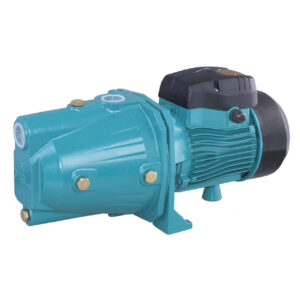Every day, billions of people unknowingly consume contaminants in their tap water. Reverse osmosis water filters stand as a bulwark against this silent crisis, ensuring that our need for clean water is met with cutting-edge technology. It’s no wonder, then, that this method has become a staple in modern water purification strategies.
Originating from the desire to make seawater drinkable, reverse osmosis has evolved significantly since its inception in the mid-20th century. This process removes up to 99% of dissolved salts, particles, and other unwanted substances from water. As a result, households, industries, and even space missions rely on it, showcasing its remarkable adaptability and necessity.

Source: thdstatic.com
Unraveling the Science of Reverse Osmosis
Reverse osmosis is a fascinating process that purifies water by pushing it through a special membrane. This membrane traps contaminants, allowing only clean water to pass through. It’s highly effective at removing impurities like salts, bacteria, and even some chemicals.
In the reverse osmosis water filter system, water pressure plays a crucial role. High pressure helps push the water molecules through the membrane. This process can produce purified water that meets high standards for both residential and industrial use.
A key component of reverse osmosis is the semi-permeable membrane. This membrane acts like a fine sieve, blocking larger molecules and letting only small water molecules through. It’s made from special materials that ensure durability and effectiveness.
Reverse osmosis systems also include pre-filters and post-filters. The pre-filters remove large particles and some chemicals before the water reaches the membrane. Post-filters catch any remaining impurities, ensuring the water is as clean as possible.
The Process Behind Reverse Osmosis
The process of reverse osmosis begins with water entering the system through an intake pipe. This water typically goes through a pre-filter to remove large particles like dirt and sediment. Next, it reaches the main chamber where the semi-permeable membrane is located.
Inside the main chamber, water is subjected to high pressure. This pressure forces water molecules through the membrane, while contaminants are trapped and flushed away. The clean water then collects in a storage tank, ready for use.
The efficiency of reverse osmosis systems can be measured by the TDS (Total Dissolved Solids) level. A lower TDS level indicates purer water, making reverse osmosis an excellent choice for ensuring water quality. Many households and businesses rely on this process for safe drinking water.
Key Components of a Reverse Osmosis Water Filter
A reverse osmosis system includes several key components that work together. The pre-filter is the first line of defense, removing large particles and certain chemicals. This helps extend the life of the main membrane by preventing clogs.
The semi-permeable membrane is the heart of the system. Its job is to trap contaminants and let clean water pass through. Post-filters are used at the end of the process to catch any remaining impurities, ensuring the highest water quality.
Some systems also have additional features like UV lights and alkaline filters. These can provide extra purification and enhance the taste of the water. These advanced components make reverse osmosis systems highly effective and versatile.
The Process Behind Reverse Osmosis Water Filter
Understanding how reverse osmosis works starts with water entering the system through an intake pipe. The water first goes through a pre-filter to remove large particles like dirt and sediment. This initial phase helps protect the main membrane from damage.
High-Pressure Filtration
Once pre-filtered, the water reaches the main chamber. Here, high pressure is applied to push the water molecules through the semi-permeable membrane. This pressure is essential for separating impurities from the water.
The membrane acts as a barrier. It blocks contaminants such as salts, chemicals, and bacteria. Clean water passes through, while the unwanted substances are flushed away.
The efficacy of this process can be observed in various settings. According to this post, people have observed significant improvements in their water quality after using reverse osmosis systems.
Role of Membranes
Semi-permeable membranes are made from special materials that ensure effective filtration. They have microscopic pores that allow only water molecules to pass. Larger contaminants are restricted and removed.
The quality of the membrane determines the system’s efficiency. High-quality membranes last longer and provide better filtration. Therefore, selecting the right membrane is crucial for optimal performance.
Membranes can vary in their composition. Some are more resistant to chemicals, while others are designed for specific types of contaminants. This variability allows customization based on specific needs.
The Final Stages
After passing through the membrane, water often goes through a post-filter. Post-filters catch any remaining impurities that might have escaped the membrane. This ensures the water is as pure as possible.
Some systems include additional stages like UV sterilization. These extra steps offer added purification, removing any lingering bacteria. Such systems are ideal for environments requiring extremely high water quality.
The final clean water is stored in a tank, ready for consumption. This multi-stage process guarantees that the water is safe and tastes better. Reverse osmosis remains one of the most reliable methods for water purification.
Key Components of a Reverse Osmosis Water Filter
Every reverse osmosis water filter includes several essential components that ensure effective water purification. The pre-filter is the first component, responsible for removing large particles like dirt and sediment. This step protects the main membrane from potential damage.
The semi-permeable membrane is the core element of the system. It acts as a barrier that filters out contaminants while allowing clean water to pass through. The quality and material of the membrane play a crucial role in the system’s efficiency.
Post-filters are used to catch any remaining impurities after the water has passed through the membrane. These filters ensure the highest purity level for the end water product. Some systems may also include additional filtration stages, like UV lights, for extra cleaning.
The final component is the storage tank, which holds the filtered water until use. This tank ensures that purified water is available on demand. Advanced systems often have sensors to monitor water quality, maintaining the highest standards.
The Extensive Uses of Reverse Osmosis
Reverse osmosis is widely used for residential water purification. Many homes have reverse osmosis water filter systems to ensure their drinking water is free from contaminants. Reverse osmosis water filter systems provide a reliable source of clean, safe water.
In the industrial sector, reverse osmosis is crucial. It’s used in processes requiring high-purity water, such as pharmaceuticals and electronics manufacturing. These industries benefit from the technology’s ability to remove nearly all impurities.
Agriculture also leverages reverse osmosis. Farmers use it for irrigation, ensuring that their crops receive pure water, free from harmful salts and chemicals. This can lead to healthier plants and better yields.
Reverse osmosis water filter is essential in areas with limited access to fresh water. For example, desalination plants use it to convert seawater into potable water. This technology is key for countries and regions affected by water scarcity.
The food and beverage industry utilizes reverse osmosis to maintain quality. Beverage companies use it to ensure their products are free from contaminants. Similarly, breweries may use purified water to maintain the consistency and taste of their beer.
Even in space missions, reverse osmosis plays a role. Astronauts use compact reverse osmosis systems to recycle their water supply. This ensures they have access to clean water while on long-duration missions.
Reverse Osmosis in Residential Contexts
Reverse osmosis water filter are becoming increasingly common in homes. These systems provide families with clean, safe drinking water by removing contaminants. Many households appreciate the peace of mind this technology offers.
Installing a reverse osmosis system under the kitchen sink is a popular choice. This placement ensures easy access to purified water for drinking and cooking. It’s a convenient and practical solution for everyday needs.
Another benefit of residential reverse osmosis water filter systems is improved taste. By removing chlorine and other chemicals, these systems make water taste better. This cleaner, fresher taste can encourage more water consumption, promoting better health.
Using reverse osmosis at home also reduces reliance on bottled water. This not only saves money but also helps the environment by reducing plastic waste. It’s a sustainable option that supports a greener lifestyle.
Some advanced systems offer additional features, like remineralization filters. These filters add essential minerals back into the purified water. This enhancement can improve the overall health benefits and taste of the water.
Industrial Applications of Reverse Osmosis
Reverse osmosis is invaluable in the industrial sector. It ensures high-purity water is available for various processes. Industries such as pharmaceuticals rely on this technology for clean water in drug production.
Electronics manufacturing also benefits from reverse osmosis. Water used in this industry must be ultra-pure. Contaminants can cause defects in products like microchips, making clean water crucial.
In the food and beverage industry, reverse osmosis is used for product quality. Beverage producers use it to ensure the purity of their drinks. The process helps maintain consistent taste and safety standards.
Agriculture can leverage reverse osmosis for irrigation. Farmers use it to provide clean water to crops, helping them grow healthier. Removing salts and chemicals from irrigation water can lead to better yields.
Power plants use reverse osmosis for boiler feed water. This ensures that the water used is free from impurities that could damage equipment. Clean water in power plants contributes to efficient and safe operations.
In areas with water scarcity, reverse osmosis helps in desalination. It converts seawater into potable water, making it a vital solution for many regions. This application is critical for providing drinking water in arid areas.
Evaluating the Efficiency of Reverse Osmosis Water Filters
Evaluating the efficiency of reverse osmosis water filters is essential. These systems aim to remove up to 99% of contaminants from the water. Understanding their effectiveness helps users make informed decisions.
The Total Dissolved Solids (TDS) level is a key indicator. A lower TDS level means purer water, showing that the filter works well. Regularly checking TDS levels can ensure your system is functioning properly.
Another factor is the rejection rate of contaminants. Higher rejection rates indicate more effective filtration. A well-maintained system should consistently achieve high rejection rates for various impurities.
Water pressure also impacts efficiency. Higher pressure improves filtration performance. Ensuring your system operates at the correct pressure can enhance its effectiveness and longevity.
The lifespan of the filters and membranes plays a significant role too. Regular maintenance and timely replacement are crucial. Proper care ensures consistent performance and extends the system’s life.
Overall, evaluating these factors can help ensure you get the best from your reverse osmosis system. An efficient system provides peace of mind with clean, safe water for all uses.
How Effective are Reverse Osmosis Filters?
Reverse osmosis filters are highly effective at removing contaminants. They can eliminate up to 99% of impurities, including heavy metals, bacteria, and dissolved salts. This makes them a popular choice for both residential and industrial applications.
A significant measure of their effectiveness is the Total Dissolved Solids (TDS) level. Lower TDS levels indicate higher water purity, which is a clear sign of the filter’s efficiency. Regular testing helps ensure the system remains effective.
The ability to filter out specific contaminants also sets these filters apart. For instance, they can remove chlorine, which affects water taste and smell. Additionally, they can filter out harmful chemicals and pathogens, making the water safer to drink.
The performance of reverse osmosis systems depends on proper maintenance. Regularly changing filters and membranes ensures they work at their best. Neglecting maintenance can reduce the system’s efficiency and lifespan.
Some advanced reverse osmosis systems come with extra features to boost effectiveness. These might include UV sterilization or remineralization filters. Such additions can further enhance the quality and safety of the water.
Factors Affecting the Performance of Reverse Osmosis Filters
Many factors can influence the performance of reverse osmosis filters. Water pressure is one key factor, as higher pressures generally improve filtration efficiency. Low pressure can result in inadequate contaminant removal.
The condition of the filters and membranes is also crucial. Over time, they can accumulate dirt and silt, reducing their effectiveness. Regular maintenance and timely replacement are essential to keep the system operating efficiently.
Water temperature can affect the filtration process. Colder water is denser, making it harder to push through the membrane. Most systems are optimized for room temperature water, ensuring consistent performance.
The quality of the incoming water is another important factor. Highly contaminated water may clog the filters more quickly. Pre-treatment, such as sediment filters, can help manage this issue.
System design and quality also play a role. Higher-quality systems often feature more robust components and advanced technologies. These can enhance the overall effectiveness and lifespan of the system.
Lastly, the frequency of use impacts performance. Frequent use may wear out components more quickly, requiring more frequent maintenance. Keeping track of usage patterns can help homeowners plan for timely upkeep.
Decoding the Maintenance of a Reverse Osmosis Water Filter
Regular maintenance is crucial for keeping your reverse osmosis water filter in top shape. One of the first steps is replacing the pre-filters. These filters usually need to be changed every 6 to 12 months.
Cleaning the system is another important task. Over time, sediment and biofilm can build up, affecting performance. Periodically sanitizing the system helps prevent this buildup and keeps the water clean.
Don’t forget about the membrane, the heart of the system. Membranes should be replaced every 2 to 3 years, depending on water quality and usage. Regular checks can help spot any issues early on.
Post-filters also need attention. These filters catch any remaining impurities and usually need changing once a year. Keeping them in good condition ensures the highest water quality.
Monitor the system for any drop in water pressure. Low pressure can indicate that filters or the membrane need replacing. Addressing this issue promptly helps maintain optimal performance.
Lastly, follow the manufacturer’s maintenance guidelines. Each system may have specific needs and schedules. Sticking to these recommendations will extend the lifespan of your reverse osmosis system.
Cleaning and Maintaining a Reverse Osmosis Filter
Regular cleaning and maintenance of your reverse osmosis filter are essential. Start by shutting off the water supply and draining the system. This ensures a safe and effective cleaning process.
Next, remove the pre-filters and post-filters. Clean the filter housings with a gentle detergent and rinse thoroughly. This step removes any built-up sediment or biofilm.
The membrane should also be inspected. If there’s noticeable wear or contamination, it’s time to replace it. Routine checks can keep the membrane in peak condition, ensuring optimal performance.
Sanitizing the system is necessary to kill any lingering bacteria or mold. Use a sanitizing solution approved for drinking water systems. Follow the manufacturer’s instructions for best results.
Once everything is clean, reassemble the system. Replace filters and membranes as needed, and make sure all connections are secure. Refill the system and check for leaks to confirm everything is functioning correctly.
Regular maintenance can extend the lifespan of your reverse osmosis filter. It ensures the system continues to provide clean, safe water. Following a consistent cleaning routine helps maintain the highest water quality.
When to Replace a Reverse Osmosis Filter
Knowing when to replace a reverse osmosis filter is crucial for maintaining water quality. Pre-filters typically need replacing every 6 to 12 months. These filters catch larger particles and protect the membrane from clogging.
The semi-permeable membrane is another critical component. It usually lasts between 2 to 3 years, depending on water quality and usage. Regular inspections can help determine if the membrane is still effective.
Post-filters also play a vital role in water purification. These should be replaced annually to ensure the highest water quality. Keeping them fresh reduces the risk of contaminants slipping through.
Pay attention to the system’s water pressure. A drop in pressure often indicates that filters need replacing. This is a sign that the filters are clogged and not working efficiently.
Some advanced systems have built-in indicators. These indicators alert you when it’s time to change the filters. Utilizing these features can simplify the maintenance process.
Regular maintenance and timely replacements ensure the system functions correctly. It keeps your water clean and safe, providing peace of mind. Following these guidelines helps extend the lifespan of your reverse osmosis system.
Viability of Reverse Osmosis Water Filters
Reverse osmosis water filters are highly effective. They remove up to 99% of contaminants, providing clean and safe water. This makes them a popular choice for many households and industries.
Cost is a significant factor when considering these systems. While the initial investment may be high, the long-term benefits often outweigh the costs. You’ll save money by reducing the need for bottled water and other less efficient filtration methods.
Maintenance is another aspect to consider. Regular filter replacements and membrane checks are essential. Proper maintenance ensures the system’s efficiency and longevity, making it a viable option for long-term use.
Environmental impact is a growing concern. Reverse osmosis systems can help by reducing plastic waste from bottled water. Additionally, they use less energy compared to other purification methods, making them environmentally friendly.
These filters are also versatile. They are used in homes, industries, agriculture, and even space missions. This wide range of applications highlights their effectiveness and applicability in various settings.
In summary, reverse osmosis water filters offer a blend of efficiency, cost-effectiveness, and environmental benefits. They are a viable solution for anyone looking to improve water quality. Proper maintenance and regular use can make these systems a valuable addition to any setting.
Cost-benefit Analysis of Installing a Reverse Osmosis Filter
Installing a reverse osmosis filter comes with initial costs. These can range from $150 to $500 for residential systems. However, the long-term savings on bottled water can offset these initial expenses.
One of the main benefits is the quality of water you receive. Reverse osmosis systems remove contaminants, making your water safer and better-tasting. This improvement in water quality can contribute to overall health and wellness.
Another advantage is reduced reliance on bottled water. This not only saves money but also reduces plastic waste. By using a reverse osmosis system, households can contribute to environmental conservation.
Maintenance costs include replacing filters and membranes. These expenses are relatively low and infrequent, especially when compared to buying bottled water regularly. Regular maintenance ensures the system remains efficient.
Let’s take a look at the cost-benefit comparison in a table:
| Aspect | Cost | Benefit |
|---|---|---|
| Initial Installation | $150 – $500 | High-quality drinking water |
| Annual Maintenance | $100 – $200 | Consistent system efficiency |
| Bottled Water Reduction | – | Environmental conservation |
Overall, the investment in a reverse osmosis system is worthwhile. The benefits, from better water quality to environmental impact, make it a valuable addition to any household. Considering these factors can help you make an informed decision.
Environmental Impact of Using Reverse Osmosis Filtration
Using reverse osmosis filtration can significantly reduce plastic waste. Many households switch to these systems to stop buying bottled water. This change helps decrease the number of plastic bottles in landfills and oceans.
Reverse osmosis systems are also energy-efficient. They use less energy compared to other water purification methods. This makes them a more sustainable option for clean water.
However, these systems do produce wastewater. For every gallon of purified water, a few gallons might be wasted. Some advanced systems now aim to reduce this wastage, making the process more eco-friendly.
Additionally, proper maintenance of the system is crucial. Regular filter replacements ensure the system operates efficiently, reducing overall energy consumption. This helps maintain a smaller environmental footprint.
Here’s a brief table showcasing the environmental impact:
| Aspect | Impact |
|---|---|
| Plastic Waste Reduction | Significant |
| Energy Consumption | Low |
| Wastewater Production | Moderate |
| Maintenance Needs | Essential for Efficiency |
Choosing a reverse osmosis system benefits both the user and the environment. With proper care, these systems provide a sustainable solution for clean water. They offer a way to enjoy pure water while being mindful of environmental impacts.
Key Takeaways
- Reverse osmosis filters remove up to 99% of water contaminants.
- They are used in both homes and industrial settings.
- Regular maintenance of these systems is very important.
- Filters need timely replacements for best results.
- This filtration method ensures high-purity, safe water.

Source: quenchwater.com
Frequently Asked Questions
Wondering about reverse osmosis and how it works? Here are some common questions people ask. These answers will help you understand this water purification system better.
1. How does reverse osmosis work?
Reverse osmosis works by pushing water through a special membrane that filters out contaminants. This membrane blocks particles, salts, and other impurities, allowing only clean water to pass through.
The process usually involves several stages, starting with pre-filters that remove large particles. The main membrane then handles finer filtration, delivering high-purity water at the end.
2. What types of contaminants can reverse osmosis remove?
Reverse osmosis systems effectively remove a wide range of contaminants. These include heavy metals like lead and mercury, as well as chemicals such as chlorine and pesticides.
The systems can also filter out bacteria and viruses, making the water safe to drink. Basically, if it’s harmful or unpleasant in your water, reverse osmosis can probably remove it.
3. How often should I replace the filters?
Typically, pre-filters need replacement every 6 to 12 months. The semi-permeable membrane should be replaced every 2 to 3 years for optimal performance.
You should also replace post-filters annually to maintain high water quality. Regular maintenance ensures your system continues to work efficiently over time.
4. Is reverse osmosis environmentally friendly?
Reverse osmosis systems help reduce plastic waste by providing an alternative to bottled water. They use less energy compared to other purification methods, making them more sustainable.
However, they do produce some wastewater during the filtration process. Advanced systems aim to minimize this waste, making them an even greener choice for water purification.
5. Can I install a reverse osmosis system myself?
Yes, many reverse osmosis systems are designed for easy DIY installation. They come with detailed instructions and all the necessary components for setting up under your sink or in another location.
If you’re not comfortable installing it yourself, professional services are available too. Either way, you’ll soon enjoy clean and safe drinking water at home.
Conclusion
Reverse osmosis water filters provide an effective solution for removing a wide range of contaminants from water. Their applications span from residential homes to industrial settings, making them versatile and valuable. With proper maintenance, these systems offer long-term benefits.
Understanding the key components and regular upkeep is crucial. This ensures the system works efficiently, providing clean, safe water continuously. Investing in a reverse osmosis system is not only cost-effective but also environmentally friendly.




